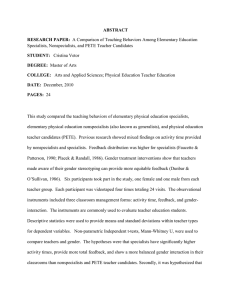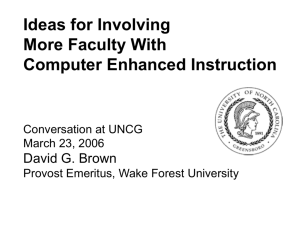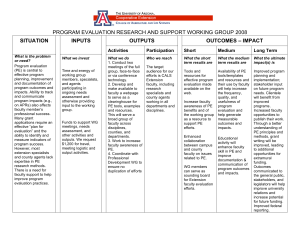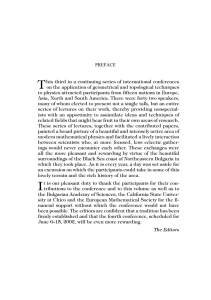Running Head: Comparing Teaching Behaviors
advertisement
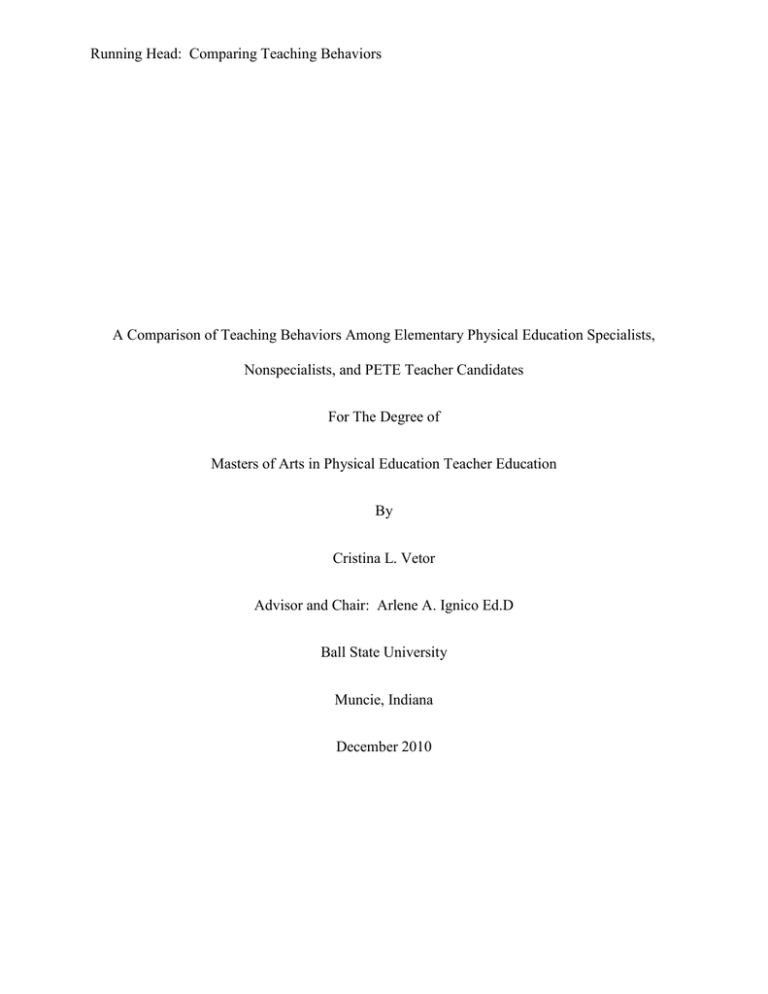
Running Head: Comparing Teaching Behaviors A Comparison of Teaching Behaviors Among Elementary Physical Education Specialists, Nonspecialists, and PETE Teacher Candidates For The Degree of Masters of Arts in Physical Education Teacher Education By Cristina L. Vetor Advisor and Chair: Arlene A. Ignico Ed.D Ball State University Muncie, Indiana December 2010 2 Comparing Teaching Behaviors TABLE OF CONTENTS TABLE OF CONTENTS ................................................................................................................. 2 ABSTRACT..................................................................................................................................... 3 INTRODUCTION ........................................................................................................................... 5 LITERATURE REVIEW ................................................................................................................ 7 Specialists ............................................................................................................................ 7 Nonspecialists ...................................................................................................................... 8 Specialists, Nonspecialists, PETE Teacher Candidates ..................................................... 10 Gender ................................................................................................................................ 11 METHODOLOGY ........................................................................................................................ 13 Participants......................................................................................................................... 13 Procedures .......................................................................................................................... 13 Measurements .................................................................................................................... 14 Design and Procedures ....................................................................................................... 15 RESULTS ...................................................................................................................................... 16 DISCUSSION ................................................................................................................................ 17 Future Directions ............................................................................................................... 18 Conclusions ........................................................................................................................ 17 REFERENCES .............................................................................................................................. 17 APPENDIX A ................................................................................................................................ 24 Comparing Teaching Behaviors 3 Abstract This study compared the teaching behaviors of elementary physical education specialists, elementary physical education nonspecialists (also known as generalists), and physical education teacher candidates (PETE). Previous research showed mixed findings on activity time provided by nonspecialists and specialists. Feedback distribution was higher for specialists (Faucette & Patterson, 1990; Placek & Randall, 1986). Gender treatment interventions show that teachers made aware of their gender stereotyping can provide more equitable feedback (Dunbar & O’Sullivan, 1986). Six participants took part in the study, one female and one male from each teacher group. Each participant was videotaped four times totaling 24 visits. The observational instruments included three classroom management forms: activity time, feedback, and genderinteraction. The instruments are commonly used to evaluate teacher education students. Descriptive statistics were used to provide means and standard deviations within teacher types for dependent variables. Non-parametric Independent t-tests, Mann-Whitney U, were used to compare teachers and gender. The hypotheses were that specialists have significantly higher activity times, provide more total feedback, and show a more balanced gender interaction in their classrooms than nonspecialists and PETE teacher candidates. Secondly, it was hypothesized that differences would not be evident between nonspecialists and PETE teacher candidates in the three variables. Lastly, male students would receive more interaction from teachers than female students. Results supported one hypothesis that teacher would provide more interactions with male students than female students as supported through previous findings (Papaioannou, 1995; McBride p. 255, 1990; Dunbar & O’Sullivan, 1986). Results in the remaining six hypotheses were not proven. However, PETE candidates did provide significantly more total feedback than Comparing Teaching Behaviors nonspecialists. Future studies should examine a larger population and examine the effects of an intervention on these teacher behaviors. 4 5 Comparing Teaching Behaviors Introduction Physical education is the one teaching discipline that can provide a significant learning experience for all children through a vast array of physical and interdisciplinary activities provided by an effective educator. Whether from licensed specialists, classroom teachers, or other educators, physical education should provide students with the physical activity experience that they will remember and continue the rest of their lives (Morgan & Bourke, 2008). The controversy about elementary physical education and who should be teaching the youth in this content area continues to be debated by researchers worldwide. For over 30 years, researchers have been trying to determine which educator is more successful in teaching physical education based on studies of quantity of activity (Faulkner, Dwyer, Irving, Allison, Adlaf, & Goodman, 2008), skill development (Placek & Randall, 1986), and classroom management (Faucette et al 1990, 1990, 2002). Who is qualified to teach physical education? -- licensed specialists with methods in physical education (DeCorby, Halas, Dixon, Wintrup, & Janzen, 2005) or licensed nonspecialists with methods in multiple disciplines, including physical education (Xiang, Lowy, & McBride, 2002). Elementary education students in pre-service training define classroom management as “planning, managing themselves, their organization, time use, and environmental issues, as well as managing and motivating children” (Humphries & Ashy, 2006, p. 185). One of the most important factors in teaching physical education is maximizing opportunities for children in appropriately designed activities (Placek & Randal, 1986). Even though studies have described the differences between organizational methods of specialists and nonspecialists, (Faucette et al, 1990; 1990, 2002), there has not been a study comparing specialists, nonspecialists (also referred to as generalists), and PETE teacher candidates. PETE research has suggested that teacher candidates compile exceptional activity time and feedback scores when Comparing Teaching Behaviors 6 daily lessons are planned. Overall, lesson planning of PETE candidates improves teaching behaviors. The purpose of this investigation was to compare teaching behaviors among elementary physical education specialists, nonspecialists, and PETE teacher candidates during their physical education lessons. Research Hypotheses 1. Specialists have significantly higher activity time than nonspecialists. 2. Specialists have significantly higher activity time than PETE teacher candidates. 3. Specialists have significantly more total student feedback than nonspecialists. 4. Specialists have significantly more total student feedback than PETE teacher candidates. 5. There will be no significant difference between the activity time provided by PETE teacher candidates and nonspecialists. 6. There will be no significant difference between total feedback provided by PETE teacher candidates and nonspecialists. . 7. Teachers will interact with male students’ more than female students. Comparing Teaching Behaviors 7 Literature Review Specialists Many researchers argue a need for a physical education specialist in the classroom since having a licensed physical education teacher in this position helps promote a physically active climate in the school. For example, school systems that have intramural programs in place with a specialist-led instructor have a larger percentage of their student population participating. It also helps to make certain the recommended physical activity levels are provided to children (Faulkner et al, 2008). Activity levels can always be increased by evaluating teaching behaviors. Intervention strategies were performed on two groups of physical educators on their teaching classroom management skills, also labeled as teaching behaviors. Physical educators were divided into two randomly assigned groups; experimental and control. Both groups were scored on four teaching behaviors: management, activity time, instruction, and waiting time. A pre-test and post-test were recorded for both groups in the four teaching behaviors. The experimental group was provided with an intervention of a two-hour lecture and two-hour practicum. Post tests for the experimental group revealed significant increases in activity time. The results suggest that short intervention training on teaching behaviors among specialists can improve classroom management; specifically student activity time. Most studies report that specialists provide more activity time, feedback than nonspecialists. In addition, students of specialist-led classrooms participate in more skill development activities than game play which characterized nonspecialists’ classroom activities (Faucette & Patterson, 1990). One study, however, reported no difference between the amount of activity time provided by specialists and nonspecialists (Placek & Randall, 1986). Comparing Teaching Behaviors 8 Specialists spend a large amount of their lesson on instruction and feedback. Students in a physical education classroom require additional explaining, directing, and clarification (Faucette & Patterson, 1990) because during appropriately designed lessons where skills are being practiced and scrimmaged, students need “feedback in order to improve their performance” (Placek & Randall, 1986, p. 161). Even feedback from a distance (Patterson & Van Der Mars, 2008) proved to be beneficial for on-task behavior and increased activity levels. To reiterate, students were more likely to participate during designed lessons that allowed for skill development whether students were getting close or distant feedback from their teachers. Specialists organize and plan lessons based on individual differences of the children in their classrooms. “Everyone is different and moves at their own pace” (DeCorby, Halas, Dixon, Wintrup, Janzen, 2005). In addition, a study on verbal descriptions performed on specialists and nonspecialist on throwing skills revealed that specialists demonstrated more pedagogical theories of content knowledge and skill than nonspecialists (Block & Beckett, 1990). However, Placek & Randall (1986) reported that even if specialists design more appropriate activities, content knowledge does not always manufacture “maximal student participation and success” according to their study between specialists and nonspecialists academic learning time in physical education (p. 161). Nonspecialists (Generalists) Researchers describe the overall knowledge of physical education as a foreign language to generalists. Perceptions of classroom teachers who were required to teach physical education describe it as overwhelming and stressful (Humphries & Ashy, 2006). Because of an overloaded curriculum, physical education was usually dropped from the schedule or it became recess. If Comparing Teaching Behaviors 9 teachers had time in the day, they organized activities where classes participated in large-sided, competitive games that highlight athletics (Morgan & Bourke, 2008) or where children stood in line for long periods waiting to participate (Faucette & Patterson, 1990). Children did not have the opportunity to “engage in skill practice or gymnastics and dance activities” (p. 287) or work in “small groups, with partners, or individually” (Faucette, McKenzie, & Patterson, 1990, p. 289). Morgan & Bourke (2008) describe this experience as a poor quality program in that children were not given “an opportunity for success, enjoyment, and physical activity” (p. 18). Placek & Randall (1986) encourage nonspecialists to analyze lessons and modify games so that children can have higher activity time and a more enjoyable experience. The quality of nonspecialists’ physical education experience as a child appears to contribute to the expressed low confidence levels in teaching physical education (Morgan & Bourke, 2008). Nonspecialists who are required to teach physical education along with other subjects identified that low confidence levels and a crowded or unknown physical education curriculum created barriers for them so physical education was eliminated from daily activities. The researchers found that nonspecialists felt students would not benefit from an inadequate lesson physical education lesson. Consequently, it was simply dropped from the daily plans (Morgan & Hansen, 2008). Nonspecialists reported these low confidence levels stemmed from both a negative experience personally in physical education and their lack of competence to teach effective content. However, if nonspecialists were more confident and knowledgeable in a particular area of physical activity, they were more apt to teach that particular content (Morgan & Bourke, 2008). Evidence of pre-service programs and physical education curriculum such as SPARK, has revealed that nonspecialists can improve their physical education content knowledge, activity time and overall teaching. Even though nonspecialists improved their Comparing Teaching Behaviors 10 teaching behaviors, according to Xiang, Lowy, & McBride (2002) preservice nonspecialists still reported inadequate knowledge and proficiency, through perceived qualitative evaluation, to teach physical education even after taking physical education methods courses. Conversely, other interventions with preservice classroom teachers’ revealed increased positive attitudes toward physical education and increased student activity levels (Humphries et al, 2006). Findings confirmed that after interventions, teachers learned how to organize, share, and locate equipment. They also learned to function more efficiently with equipment set up and take down (Faucette et al, 2002). Sallis, McKenzie, Alcaraz, Kolody, Faucette, & Hovell, (1997) compared three groups of teachers on a qualitative assessment of fitness gains. Two groups were trained in the SPARK curriculum, specialists and nonspecialists. The third group was nonspecialists, classroom teachers, who were not given the curriculum training. Results revealed that specialists with curriculum training provided the most fitness gains. Specialists and Nonspecialists and PETE Candidates Similarities and differences exist between specialist-led and nonspecialist-led physical education. A three group comparison study from Sallis et al, (1997) confirmed that physical education was not being provided by any physical education teacher in the quantity (150 minutes per school week) that students should receive in physical education. In another study, self-report data by specialists and nonspecialists showed significant differences in resources and participation in interschool athletics. However, teachers from both groups reported no differences in lessons, minutes, and amount of “moderate or vigorous physical activity in lessons Comparing Teaching Behaviors 11 across four grade levels” (Faulkner et al, 2008, p. 412). In a similar study examining the teaching behaviors of PETE teacher candidates, researchers recorded student activity time, waiting time, and off-task behavior. Teachers taught two lessons; one of which was planned and the other was unplanned. Results showed that activity time increased, waiting time decreased and student off-task behavior decreased for only the planned physical education lessons (Byra & Coulon, 1992). The SPARK intervention comparison study between three teacher types found that students were more active in a specialist-led classroom (40 minutes) compared to a nonspecialist-led classroom (33 minutes). They also confirmed that students burned more calories each week through moderate to vigorous activity, with girls improving the most in a specialist-led classroom. The researchers reported that during a 36-week school year, students in specialist-led classes spend about 13 more hours in moderate to vigorous physical activity than students in control classes (Sallis et al, 1997). Overall, specialist-led classes were superior to those of nonspecialist-led classes in providing students the most activity time. Gender Gender-typing, describes the differential treatment or perception of treatment between boys and girls in the classroom. Mixed findings have been established from students and teachers perceptions and quantitative intervention methods. Student perceptions of differential treatment based on “class goal structure” revealed that teachers favor high achievers, boys or girls, in physical education (Papaioannou, 1995, p. 29). In addition, Dunbar & O’Sullivan (1986) observed two female nonspecialist physical education teachers’ praise, desists, questioning, and demonstrations. Baseline data was analyzed and researchers conducted multiple conferences Comparing Teaching Behaviors 12 with teachers to provide information and suggestions about their differential feedback favoring boys. Results revealed more feedback was provided to boys prior to intervention. After feedback interventions, however, teachers showed more equal distribution of feedback between boys and girls. Yet, the physical education teachers reported that they found it difficult to change their behavior (Brown, Brown, & Hussey, 1996). These findings suggest that physical education specialists and nonspecialists have the capability of diminishing their inequitable interactions with boys and girls. In summary, teachers can become more aware of their behaviors and intervention studies suggest that they can reduce the differential treatment of girls and boys. Comparing Teaching Behaviors 13 Methodology Participants The participants were selected through a non-probability, convenience sample. Six elementary physical education teachers were asked to participate. The six teachers consisted of two specialists, two nonspecialists and two PETE teacher candidates in schools around central Indiana. A specialist is described as a licensed elementary physical education teacher. A nonspecialist (generalist) is a licensed educator who is not a licensed physical education teacher. A PETE teacher candidate is a physical education teacher education student who is pursuing a degree and licensure in physical education. The specialists and nonspecialists had a wide array of teaching experience, five to thirty-seven years. The PETE students complete an 11-day practicum in local elementary schools, meeting a university requirement for their major. Each group included one female and one male, totaling three females and three males. Procedures A list of local teachers from the three groups who fit the inclusion criteria were compiled and conveniently selected. Principals of the qualified participants were contacted by email and phone and asked to participate. They were provided an abstract of the study either by email or in person. Because the PETE teacher candidates were located in a school with a participating specialist, permission had already been granted to videotape lessons. The principals provided a letter which stated that the researcher had permission to conduct the study in the physical education classroom. A consent form was then provided to the teacher, allowing permission to perform the study in their physical education classroom. The PETE teacher candidates were Comparing Teaching Behaviors 14 given the same form to acquire their personal permission to observe their teaching behaviors in the study. Participants were then contacted by phone and email to schedule times to videotape the lessons. Each participant was observed four times. The researcher received approval to conduct the study through the Institutional Review Board at Ball State University. Measurements The six participants were each visited four times for a total of twenty-four visits. All the visits were scheduled in advance. The researcher set up a camera in a corner of the gym fifteen minutes prior to class. All twenty-four visits were completed over the course of one month. The recording sheets represented time on task, feedback, and gender interaction. The researcher recorded the feedback sheet during the visit. The researcher then transferred all videos onto DVDs to view. Each lesson was viewed two more times in order to record activity time and gender interaction. One group of teachers had 45-minute class periods and two groups had 30minute class periods. Therefore, percentages were used to compare groups. The researcher viewed the tape at a private location to record the behaviors. The coding forms assessed student activity time, the quantity and quality of feedback, and boy and girl interactions. The three forms are commonly used in physical education teacher education programs to assess teacher effectiveness. Activity time was scored in four areas: instruction, activity, management, and waiting. Every fifteen seconds, the researcher recorded I, A, M, or W based on what 51% of the students were doing during that interval. Activity time (A) is defined as the time when most students (over 50%) are involved in physical movement, e.g. catching a ball; throwing at a target. Management (M) is considered the time when most students are not receiving instruction or involved in lesson activity, e.g. changing activities; getting out or putting away equipment; Comparing Teaching Behaviors 15 listening to behavior rules and reminders; getting a drink. Instruction (I) is the time when most students are receiving information about how to move or perform a skill, e.g. how to move using all the space; watching a demonstration; listening to instructions. Percentages were then calculated to determine how much time the teacher spent in each area during the lesson. The feedback form shows all feedback given to students by the teacher. The sheet allows the researcher to record the gender of the student receiving it and whether the feedback is specific, general, group, or individual. Specific feedback was recorded as individual or group and whether it was related to skill or behavior, e.g. “Your toes are nicely pointed.” General feedback was also recorded as individual or group, e.g. “Good job, Fantastic.” Totals for each category were determined so that group means for total, general, and specific feedback could be compared. The third sheet provides data identifying gender interactions. The researcher recorded how many times a teacher interacted with a boy or a girl. Students’ names were not used in recording the data, only the gender. Means were calculated for boy interactions and girl interactions. Design and Procedures This study was a quasi-experimental design due to the locality and availability of participants. Means were calculated for each group to compare specialists, nonspecialists, and PETE candidates as well as by gender. Descriptive statistics were calculated and table charts were created using Microsoft Excel 2007. A further analysis was completed using SPSS version 17.0 for Windows. Numerous nonparametric t-tests, Mann-Whitney U, were conducted between teacher groups and gender types. The alpha level was established at p < 0.05. 16 Comparing Teaching Behaviors Results Descriptive Statistics Descriptive statistics revealed that specialists had higher percentage means in activity time (M=55% SD=.16) compared to PETE candidates (M=49%, SD=.11), and nonspecialists (M=45%, SD=.17). Total feedback means were led by PETE candidates (M=2.15/min, SD=0.62), followed by specialists (M=1.84/min, SD=1.01) and nonspecialists (M=1.01/min, SD=.45). Gender interaction means were calculated to compare the male teachers and the female teachers. Both males (M= 66%; SD= .12) and females had higher means for boy interaction than girl interaction (M= 56%; SD= .06). Mann-Whitney U Nonparametric t-tests, Mann-Whitney U, were used to analyze the eight hypotheses. The last hypotheses regarding all teachers will interact more with male students that female students was proven significant (t(N=6) = .024 p < .05). Even though not listed as hypotheses, significance was evident of total feedback among PETE teacher candidates and nonspecialists. Data revealed significant values between total feedback given between PETE teacher candidates and nonspecialists as PETE teacher candidates compiling more total feedback per lesson (t(1,3) = .006 p < .05). The remaining seven hypotheses that were not proven have p-values listed below. 1. Specialists have significantly higher activity time than nonspecialists (t(2,3) p =.161). 2. Specialists have significantly higher activity time than PETE teacher candidates (t(1,2) p = .248). 3. Specialists have significantly more total student feedback than nonspecialists (t(2,3) p = .074). Comparing Teaching Behaviors 17 4. Specialists have significantly more total student feedback than PETE teacher candidates (t(1,2) p = .528). 5. There will be no significant difference between the activity time provided by PETE teacher candidates and nonspecialists (t(1,3) p = .874). Discussion The purpose of this investigation was to compare teaching behaviors among elementary physical education specialists, nonspecialists, and PETE teacher candidates during their physical education lessons. In addition, gender interactions were also investigated. Because only six participants were included in the study, nonparametric t-tests were used to compare teacher groups. The four hypotheses that specialists would score significantly higher than nonspecialists and PETE candidates in all three teaching behaviors were not supported. Similarly, the two hypotheses that nonspecialists and PETE candidates’ scores would not differ in activity time and total feedback was rejected. Descriptive statistics revealed that female (M = 56%, SD = .06) and male (M = 66%, SD = .12) teachers showed favor to boy students as supported through previous research that boys receive more feedback than girls (Papaioannou, 1995; McBride p. 255, 1990; Dunbar & O’Sullivan, 1986). However, significance was evident between PETE teacher candidates and nonspecialists in total feedback given per class period (t(1,3) = .006 p < .05). Additionally, the means analysis revealed that PETE (M = 2.15; SD = .62) students provided significantly more feedbacks per minute than nonspecialists (M = 1.01; SD = .45). This finding could be due to the fact that PETE candidates were being graded on their teaching behaviors while data was being collected. However, this particular finding does provide support for the PETE teaching program where they Comparing Teaching Behaviors 18 are enrolled. As well, many of the means support previous research findings in gender interaction and feedback. Specialists’ means were highest in activity time (Sallis et al, 1997; Placek & Randall, 1986) and feedback (Placek & Randall, 1986). It should be noted, however, that a significant limitation to this study was that only 6 participants were investigated; therefore results cannot be generalized to the larger population of specialists, nonspecialists, and PETE candidates. Future Directions Future research should examine a larger group of specialists, nonspecialists, and PETE candidates using a mixed-methods approach through observation and intervention strategies. In addition, another teaching group could be added to the study, such as physical education teacher education (PETE) candidates who are student teaching. This would allow for multiple correlations and differences to be assessed. Also, future researchers should ask teachers to implement a short unit of common instruction in order to control more variables within the study. Conclusions Even though the results did not support the research hypotheses, differences were apparent among specialists, nonspecialists, and PETE teacher candidates. The physical education classroom can provide children the ultimate experience through a vast array of physical activities provided by a motivated physical educator. Physical education is the one discipline that students will always remember throughout their lifetime (Morgan & Bourke, 2008). Research confirms that elementary physical education is a classroom in which many students can excel in a positive environment, if the physical education teacher embraces the Comparing Teaching Behaviors 19 subject and teaches appropriate skill development. Elementary physical education teachers have an opportunity to develop appropriate teaching behaviors that will enhance the experience for the students. “While physical activity levels may be transitory, attitudes are often more long-term” (Morgan & Bourke, 2008, p. 21). Thus, it is the proper pedagogy training, perception of the discipline, excitement, and effective delivery that enhances the overall student experience (Faulkner et al, 2008). If the teacher puts forth the excitement and effort in the subject, it is possible that students will respond positively in physical education. Comparing Teaching Behaviors 20 References Block, K., & Beckett, K. (1990). Verbal descriptions of skill by specialists and nonspecialists. Journal of Teaching Physical Education, 10, 21-37. Brown, S., Brown, D., & Hussey, K. (1996). Promote equity in the classroom. Strategies: A Journal for Physical and Sport Educators, 9, (6), 1922. Byra, M., & Coulon, S. (1992). Preservice teachers’ in-class behaviors: The effect of planning and not planning. Annual Meeting Presentation American Educational Research Association, San Francisco. Constantinou, P. (2003). Female students’ perceptions toward gender-role stereotypes in physical education. (Doctoral Dissertation, Teachers College, Columbia University, 2003). Dissertation Abstracts Database 3091239. Constantinou, P. (2008). Heightening our awareness of gender stereotypes. Strategies, Metaanalysis. January/February 2008 DeCorby, K., Halas, J., Dixon, S., Wintrup, L., & Janzen, H. (2005). Classroom teachers and the challenges of delivering quality physical education. The Journal of Educational Research, 98(4), 208-220. Dunbar, R., & O’Sullivan, M. (1986). Effects of intervention on differential treatment of boys and girls in elementary physical education lessons. Journal of Teaching Physical Education, 5, 166-175. Comparing Teaching Behaviors 21 Faucette, N., McKenzie, T., & Patterson, P. (1990). Descriptive analysis of nonspecialist elementary physical education teachers’ curricular choices and classroom organization. Journal of Teaching Physical Education, 9, 284-293. Faucette, N., Nugent, P., Sallis, J., & McKenzie, T. (2002). “I’d rather chew on aluminum foil.” Overcoming classroom teachers’ resistance to teaching physical education. Journal of Teaching in Physical Education, 287-308. Faucette, N., & Patterson, P. (1990). Comparing teaching behaviors and student activity levels in classes taught by pie. specialists versus nonspecialists. Journal of Teaching Physical Education, 9, 106-114. Faulkner, G., Dwyer, J., Irving, H., Allison, K. Adlaf, E., & Goodman, J. (2008). Specialist or nonspecialists physical education teachers in Ontario elementary schools: Examining differences in opportunities for physical activity. The Alberta Journal of Educational Research, 54(4), 407-419. Faulkner, G., Reeves, C., & Chedzoy, S. (2004). Nonspecialist, preservice primary-school teachers: Predicting intentions to teach physical education. Journal of Teaching in Physical Education, 23, 200-213. Humphries, C., & Ashy, M. (2006). ’The confidence I needed’: elementary education majors’ perceptions of teaching physical education. Teacher Development, 10(2), 179-196. McBride, R. (1990). Sex-role stereotyping behaviors among elementary, junior, and senior high school physical education specialists. Journal of Teaching Physical Education, 9, 249261. Comparing Teaching Behaviors 22 Morgan, P., & Bourke, S. (2008). Nonspecialist teachers’ confidence to teach pe: the nature and influence of personal school experiences in pe. Physical Education and Sport Psychology, 13(1), 1-29. Morgan, P., & Hansen, V. (2008). Classroom teachers’ perceptions of the impact of barriers to teaching physical education on the quality of physical education programs. Research Quarterly for Exercise and Sport, 79(4), 506-516. Oslin, J. (1996). Routines as organizing features in middle school physical education. Journal of Teaching in Physical Education, 15, 319-337. Papaioannou, A. (1995). Differential perceptual and motivational patterns when different goals are adopted. Journal of Sport & Exercise Psychology, 17, 18-34. Patterson, D., & Mars, H. (2008). Distant interactions and their effects on children’s physical activity levels. Physical Education and Sport Pedagogy, 13(3), 277-294. Placek, J., & Randall, L. (1986). Comparison of academic learning time in physical education: Students of specialists and nonspecialists. Journal of Teaching in Physical Education, 5, 157-165. Sallis, J., McKenzie, T., Alcaraz, J., Kolody, B., Faucette, N., & Hovell, M. (1997). The effects of a 2-year physical education program (SPARK) on physical activity and fitness in elementary school students. American Journal of Public Health, 87(8), 1328-1334. Spencer, R., Porche, M., & Tolman, D. (2003). We’ve come a long way-maybe. New challenges for gender equity education. Teachers College Records, 105, (9), 1774-1807. Comparing Teaching Behaviors 23 Vasiliadou, O., Derri, V., Galanis, N., & Emmanouilidou, K. (2009). Training in-service physical educators to improve class time management. International Journal of Sport Science, 5(17), 33-43. Xiang, P., Lowy, S., & McBride, R. (2002). The impact of a field-based elementary physical education methods course on preservice classroom teachers’ beliefs. Journal of Teaching Physical Education, 21, 145-161. Comparing Teaching Behaviors Appendix A IRB Topic Approval Sheet attached separately. 24
